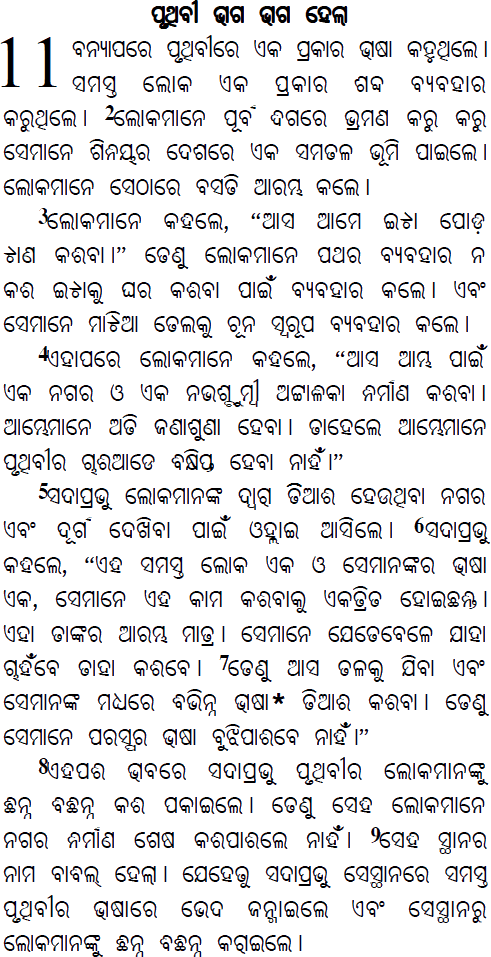I’m currently trying to transcribe an Oriya version of the Tower of Babel story from a PDF and have come across a number of letters that I can’t quite work out.
They appear in verse 3 and I think they’re conjuncts of some kind, but haven’t been able to find them. Can you help?
Here are the tricky letters:

and here’s the full text:

The first character seems to be an older typographic variant for retroflex ‹ṭ›/Unicode TTA. You can find it in Carl Faulmann’s Das Buch der Schrift, available as a PDF at Google Books. (Excellent resource for somewhat older variants of many scripts as well as reproduction of ancient scripts which has served me well in my research on the historical development of older Gujarati and Nagari scripts.) The Oriya tables appear on his page 134 (p. 155 of the PDF).
That this one is clearly a typographic variant leads me to believe the other two might be as well. I would venture a guess that the second is ‹ś› (Unicode SHA) and the third, which otherwise resembles ‹ḍ› (Unicode DDA), is likely – with the nukta underneath – ‹ṛ› (Unicode RRA) (I came across this possibility via the Mac OS X Character Viewer). If the more customary variants don’t appear anywhere in the text, that would seem to support these guesses, though the possibility of course remains that some kind of conjunct is also involved in the last two characters.
The second one might be ରି ri
and the third one might be ଡ଼ି ṛi
AIUI the vowel is sometimes joined to the consonant instead of written above it.
Seems like you’ve hit the nail on the head, “goofy” (your moniker and answer don’t match very well!).
The ‹ri› and ‹ṛi› ligatures shown in the Wikipedia article C+V table are almost identical to the forms here. it seems this double-arch ligature is a regular thing where the base letter’s headstroke arch isn’t connected to a vertical on its right side.
So I guess we have it: ‹ṭ(a)›, ‹ri› and ‹ṛi›.
*siiighhh…*
I *really* wouldn’t mind some kind of security code like they have on Blogger before posting. You know, the distorted, partly obscured combinations of letters and numbers. Maybe a “decipher this obscure script!” test! Would be fun, but yeah, I know, there are a lot of legitimate posters who would be thrown for a loop…
Ah well, I guess we just have to bear with these spam posts absent moderation…
ps- There is a poster on the weekly LINGUIST Notice Board asking for help in deciphering a copper plate inscription that he refers to as a “scroll”. I’m sending him an email to suggest he try Omniglot.
While I couldn’t find a similar looking ligature for the retroflex ‹ṭ› in any existing Oriya font, and haven’t come across this glyph variant myself, Christopher’s and goofy’s guesses seem to be correct when considered in context; if the words containing this character are read as —
ଇଟା ‘brick’
ଇଟାକୁ ‘brick’.ACC
ମାଟିଆ ତେଲକୁ ‘crude oil’.ACC
considering the retroflex as our first ‘suspect’, then it seems to fall into place.
The other two suspects — ରି and ଡ଼ି — can be viewed as shown in the image above, by using the e-Oriya OT font (available as part of the Indolipi package (http://goo.gl/XYyT)